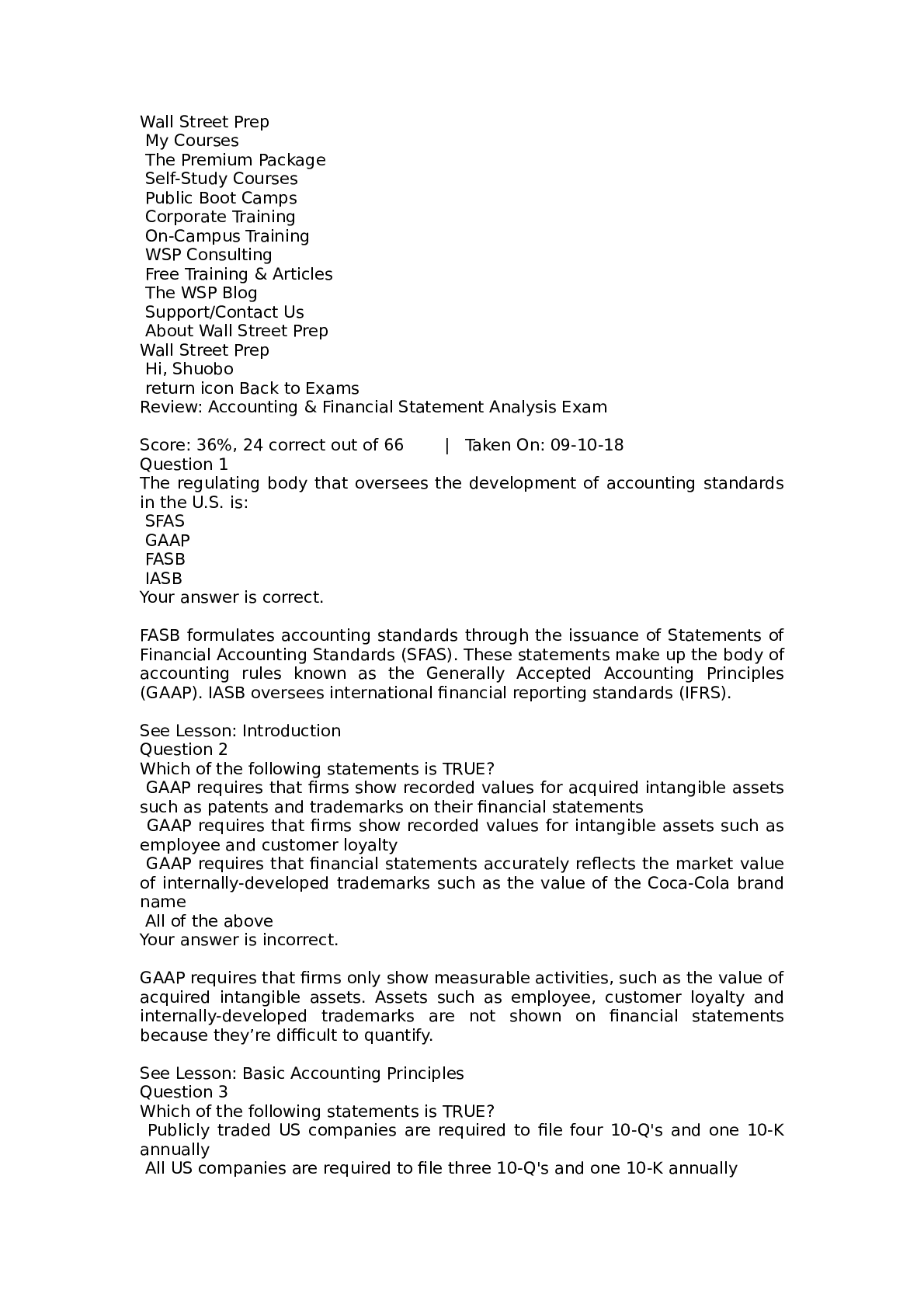Wall Street Prep
My Courses
The Premium Package
Self-Study Courses
Public Boot Camps
Corporate Training
On-Campus Training
WSP Consulting
Free Training & Articles
The WSP Blog
Support/Contact Us
About Wall Street Prep
Wall Street Prep
Hi, Shuobo
return icon Back to Exams
Review: Accounting & Financial Statement Analysis Exam
Score: 36%, 24 correct out of 66
| Taken On: 09-10-18
Question 1
The regulating body that oversees the development of accounting standards
in the U.S. is:
SFAS
GAAP
FASB
IASB
Your answer is correct.
FASB formulates accounting standards through the issuance of Statements of
Financial Accounting Standards (SFAS). These statements make up the body of
accounting rules known as the Generally Accepted Accounting Principles
(GAAP). IASB oversees international financial reporting standards (IFRS).
See Lesson: Introduction
Question 2
Which of the following statements is TRUE?
GAAP requires that firms show recorded values for acquired intangible assets
such as patents and trademarks on their financial statements
GAAP requires that firms show recorded values for intangible assets such as
employee and customer loyalty
GAAP requires that financial statements accurately reflects the market value
of internally-developed trademarks such as the value of the Coca-Cola brand
name
All of the above
Your answer is incorrect.
GAAP requires that firms only show measurable activities, such as the value of
acquired intangible assets. Assets such as employee, customer loyalty and
internally-developed trademarks are not shown on financial statements
because they’re difficult to quantify.
See Lesson: Basic Accounting Principles
Question 3
Which of the following statements is TRUE?
Publicly traded US companies are required to file four 10-Q's and one 10-K
annually
All US companies are required to file three 10-Q's and one 10-K annually
Publicly traded US companies are required to file three 10-Q's and one 10-K
annually
Publicly traded US companies are required to file one 10-K annually; 10-Q's
are typically filed but are technically voluntary
Your answer is incorrect.
Publicly-traded US companies must file three quarterly (10-Q) reports at the
end of their 1Q, 2Q and 3Q, and a 10-K at the end of their fiscal year.
See Lesson: Financial Reportings & Important Filings
Question 4
The income statement is designed to measure:
the liquidity of a firm
how solvent a company has been
the income position of a firm at a point in time
Cash inflows/outflows generated over a period of time
the accrual-based accounting profits of a firm over a period of time
Your answer is correct.
The income statement is designed to show the operations of the business
(revenues and associated expenses). The balance sheet is designed to show a
firm’s financial position, while the cash flow statement shows the amount of
cash generated by a firm.
See Lesson: Basic Accounting Principles
Question 5
The Matching Principle states that:
Costs associated with making a product must be recognized at the end of the
production process
Costs associated with making a product must be recognized immediately as
incurred
Costs associated with making a product must be recognized during the same
period as revenue generated from that product
Costs associated with making a product must be recorded during the same
period as the sales, general, and administrative expenses that are also
associated with the product
Your answer is incorrect.
Under the matching principle, costs associated with making a product must be
recorded during the same period as revenue generated from that product.
See Lesson: Basic Accounting Principles
Question 6
During the current year, accounts receivable increased from $27,000 to
$41,000 and sales were $225,000. Based on this information, how much cash
did the company collect from its customers during the year?
$239,000
$225,000
$211,000
$252,000
$266,000
Your answer is incorrect.
Accounts receivable increased by $14,000, implying that the company did not
collect that amount in cash, so cash sales were $225,000-$14,000 =
$211,000.
Read More


